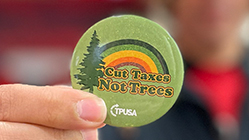Skittles Removes Food Additive Targeted in MAHA Report

Skittles will no longer include the food additive titanium dioxide as an ingredient in its products, a move that comes as the Make America Healthy Again (MAHA) Commission report noted the chemical’s potential health risks.
A company spokesperson confirmed to Bloomberg News on Tuesday that the additive was removed from Skittles by the end of last year. While titanium dioxide has not been banned in the United States, it was prohibited in the European Union in 2022 due to concerns that nanoparticles may accumulate in the body and cause damage to DNA. Mars, the parent company of Skittles, had pledged to eliminate the additive as far back as 2016.
The MAHA Commission recently identified titanium dioxide as one of several food additives that may have “carcinogenic effects.”
“Over 2,500 food additives — including emulsifiers, binders, sweeteners, colorings, and preservatives — may be used to mimic the taste and texture of conventional food and increase its shelf life,” the report stated. “Studies have linked certain food additives to increased risks of mental disorders, ADHD, cardiovascular disease, metabolic syndromes and even carcinogenic effects.”
“Titanium Dioxide, widely used in a range of candies and sauces, may cause cellular and DNA damage,” it noted.
Despite removing titanium dioxide, Skittles still contains synthetic dyes such as Red 40, Yellow 5, and Blue 1. Health and Human Services Secretary Robert F. Kennedy Jr. has taken aim at food dyes and other chemical additives, criticizing their continued use in processed foods and pushing for their elimination. Last month, HHS and the FDA announced a plan to work with food manufacturers to phase out synthetic dyes by the end of 2026.
“Certain food colorings, such as red 40, which is present in widely-consumed products have been associated with behavioral issues in children, such as increased hyperactivity and symptoms consistent with ADHD,” the MAHA report added. “Additionally, preliminary evidence suggests a possible association between the consumption of food colorings and autism, although further long-term research is necessary to establish a definitive link.”

















